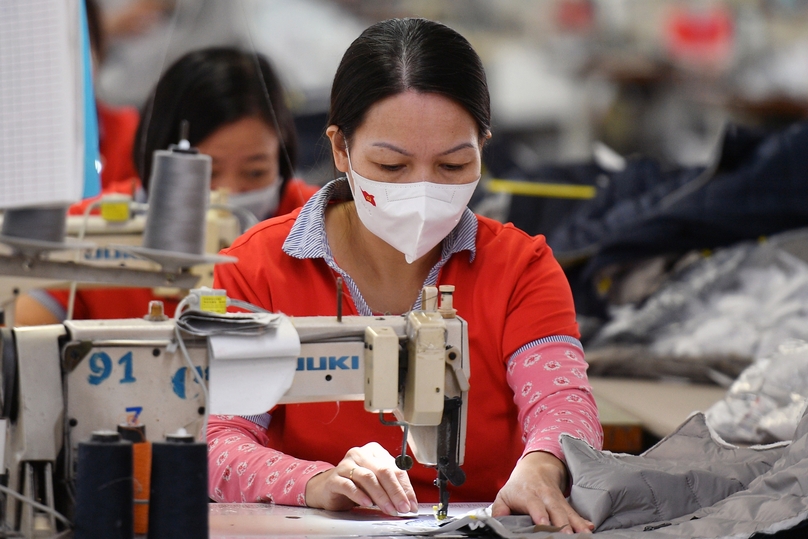Smart diversification an impressive feature of Vietnam's textile sector: RMIT lecturer
What's really impressive about Vietnam's textile sector is how it's spread its wings across 104 countries and territories. This isn't just about selling more, it's about smart diversification – selling different products to different places, writes Dr Bui Duy Tung, economics lecturer at RMIT Vietnam.

Dr Bui Duy Tung, an economics lecturer at RMIT Vietnam. Photo courtesy of the university.
Vietnam's textile industry has its sights set on a bold target for 2024: hitting $44 billion in export revenue, a 9.2 per cent jump from last year.
This goal isn't just about bouncing back; it's a clear sign of Vietnam's strategic edge in the global textile game. But let's not sugarcoat it – there are hurdles ahead. From the unpredictability of supply chains to the rise of trade protectionism, not to mention the economic policies of major players like the U.S, the path to success is far from straightforward.
What's really impressive about Vietnam's textile sector is how it's spread its wings across 104 countries and territories. This isn't just about selling more; it's about smart diversification – selling different products to different places. This strategy is crucial, especially when you consider the risks of putting all your eggs in one basket, like relying too much on the U.S market. Sure, there's a bit of a rebound expected in exports to the U.S, but it's a reminder that variety is the spice of trade.
Vietnam's knack for forging strong trade agreements and maintaining solid international relationships is a game-changer in today's trade climate. These agreements are more than just paperwork; they're a shield against trade barriers and a boost for exports. The Vietnamese government and the Agency of Foreign Trade deserve a nod here for their role in making the most of these agreements.
With the increasing global focus on environmental sustainability, the Vietnamese textile and garment industry's commitment to green production and greenhouse gas emission reduction is commendable. This shift towards sustainable practices is not only an ethical imperative but also a competitive necessity in the face of changing consumer preferences and regulatory demands.
The VinaCapital Group report provides a positive outlook for Vietnam's textile and garment exports, particularly towards the U.S. The noted reduction in inventories of U.S clothing brands and retailers by 5-7% at the end of 2023 compared to the previous year suggests a potential increase in demand for new orders in 2024. This is an important development, given the U.S’s status as the largest importer of Vietnamese textile and apparel products.
The report's indication that apparel exporters have orders in hand which are expected to last until the end of March 2024 is a strong indicator of the industry's robustness and the confidence global buyers have in Vietnamese exports. This forward visibility into order books is critical, as it provides a tangible measure of the industry's health and its ability to sustain and grow export revenues.

Texttile workers in a Vietnamese factory. Photo courtesy of VietNamNet.
As we approach 2024, Vietnam's textile and garment industry, a crucial sector of its economy, faces a confluence of challenges that could significantly shape its trajectory. Analyzing these challenges critically offers insights into the industry's adaptability, resilience, and potential for future growth.
Vietnamese textile and garment enterprises are grappling with rising input costs, including a 3% increase in energy and electricity prices and a similar rise in exchange rates since the end of the second quarter of 2023. This situation has created a complex business environment, affecting market competitiveness, financial stability, and production costs. Such cost pressures necessitate strategic responses, including exploring more efficient production methods and possibly diversifying supply chains to mitigate these increases.
The industry has observed a decline in the quantity of export orders. These orders have become more demanding, often with short-term plans and extended delivery times. This change adversely impacts production schedules and business results. In 2023, this trend has necessitated a pivot in operational strategies, pushing businesses to be more agile and responsive to market demands. The challenge lies in maintaining quality and delivery commitments while navigating the fluctuating order volumes and specifications.
There has been a notable shift in the structure of export products. Traditional items such as sweatshirts, shorts, and children’s clothing are experiencing a decline, while there is a growing demand for products like protective safety workwear, suits, medical clothes, and jeans. This shift indicates a significant change in global consumer preferences and market needs. Vietnamese textile businesses must adapt by diversifying their product lines and investing in new production capabilities to cater to these emerging segments. This change not only represents a challenge but also an opportunity to capture new markets and customer segments.
Vietnamese textile and garment enterprises face regulatory challenges, including the adoption of Extended Producer Responsibility (EPR) and the Carbon Border Adjustment Mechanism (CBAM), as well as adapting to the “sustainable fashion” strategy over “fast fashion.” This shift necessitates a thorough reassessment of production and supply chain practices to meet these new regulatory requirements and consumer preferences. Additionally, complying with the EU's OECD supply chain due diligence directive and Germany's supply chain scrutiny laws will require enhanced transparency and accountability in operations.
The trend towards using and recycling old clothes, as exemplified by France's government incentive program, represents a significant shift in consumer behaviour. This trend could lead to a decrease in demand for new clothing, impacting sales for the textile and garment industry. To adapt, Vietnamese companies must explore innovative business models, such as circular fashion, which focuses on the lifecycle of products, promoting reuse and recycling.
The Vietnamese textile and garment industry in 2024 will navigate through a landscape marked by economic, environmental, and regulatory challenges. Success in this environment will depend on the industry's ability to adapt to changing market demands, invest in sustainable practices, and embrace technological advancements. Additionally, navigating the competitive global market will require a focus on quality, innovation, and efficient supply chain management. The industry's response to these challenges will not only determine its immediate economic performance but also shape its long-term sustainability and global competitiveness.
- Read More
Market watchdog conference in central Vietnam offers insight into amended securities law
A conference recently held by the State Securities Commission (SSC) in Danang briefed companies and market participants in central Vietnam on amendments to the Securities Law and guiding documents, as part of the authority's 2025 legal dissemination plan.
Finance - Sat, November 22, 2025 | 9:48 pm GMT+7
Central Retail incurs 6% drop in Jan-Sept revenue from Vietnam
Thailand’s top retailer Central Retail posted revenues of nearly THB35.48 billion ($1.09 billion) in Vietnam in the first nine months of this year, down 6.6% year-on-year due to exchange rate fluctuations.
Companies - Sat, November 22, 2025 | 3:32 pm GMT+7
Young leadership mindset drives SHB bank's next growth phase: exec
Young leadership would play a pivotal role as Vietnamese businesses navigate digital transformation and rising global competition, said Do Quang Vinh, vice chairman cum deputy CEO of Saigon-Hanoi Commercial Joint Stock Bank (SHB).
Banking - Sat, November 22, 2025 | 3:23 pm GMT+7
Stock market regulator holds final round of ESG-focused corporate governance contest in Hanoi
The final round of the “Vietnam ESG Challenge 2025”, a competition aimed at promoting sustainable development, modern corporate governance, and social responsibility among Vietnamese university students, took place in Hanoi on Monday.
Finance - Sat, November 22, 2025 | 10:16 am GMT+7
IFC, Vietnam's EVNNPT discuss investment in power transmission projects
Vietnam's National Power Transmission Corporation (EVNNPT) and the International Finance Corporation (IFC), a member of the World Bank Group, have discussed issues related to potential cooperation and investment in power transmission projects under the Power Development Plan VIII (PDP VIII).
Companies - Sat, November 22, 2025 | 9:23 am GMT+7
Earnings strength meets market consolidation
Global appetite for emerging markets is still cautious, constrained by high returns in developed markets amid geopolitical uncertainty, while pressure on the Vietnamese dong has been compounded by seasonal FDI profit repatriation, writes Minh Dang, head of research at Dragon Capital.
Economy - Sat, November 22, 2025 | 8:00 am GMT+7
Phat Dat pursues HCMC housing project after a decade as it restructures property portfolio
Phat Dat Real Estate Development Corp (PDR) has moved to acquire a 50% stake in AKYN Investment Trading Service JSC as part of efforts to revive a long-delayed residential project in central Ho Chi Minh City, the company said in a board resolution. Financial terms were not disclosed.
Real Estate - Fri, November 21, 2025 | 9:30 pm GMT+7
F88 wins dual workplace awards for 2025
Vietnam’s consumer finance major F88 has been named one of "Vietnam Best Places to Work" and a “Happiness at Work” enterprise for 2025.
Companies - Fri, November 21, 2025 | 4:07 pm GMT+7
European IP developer CTP plans large industrial-logistics project in northern Vietnam port city
CTP, a Dutch-led industrial park developer headquartered in the Czech Republic, is exploring a large integrated complex combining seaports, an airport, logistics facilities and industrial parks in the northern port city of Hai Phong.
Infrastructure - Fri, November 21, 2025 | 3:24 pm GMT+7
Vingroup to build $334 mln international port in central Vietnam
Vietnam's leading private conglomerate Vingroup will develop a modern, large-scale international port named Son Duong at the Vung Ang Economic Zone in Ha Tinh province.
Infrastructure - Fri, November 21, 2025 | 3:10 pm GMT+7
HCMC ready to operate International Financial Center: city authorities
Ho Chi Minh City has completed preparations across infrastructure, spatial planning, digital systems, organizational apparatus, and human resources to ensure Vietnam's International Financial Center can begin operating immediately after the Government issues its guiding decrees.
Economy - Fri, November 21, 2025 | 2:11 pm GMT+7
Hoa Phat Agriculture valued at over $450 mln ahead of IPO, ranking 2nd in Vietnam's livestock industry
Hoa Phat Agriculture Development JSC (HPA) has been valued at more than $450 million based on its newly announced IPO price, making it the second-largest company in Vietnam’s livestock industry after Masan MeatLife.
Companies - Fri, November 21, 2025 | 11:26 am GMT+7
Vietnam leads ASEAN in consumer optimism: UOB
Vietnam continues to lead the region in consumer optimism, driven by positive economic outlook and confidence in personal finances, according to the sixth edition of the ASEAN Consumer Sentiment Study (ACSS). UOB analysts offer an insight into their findings.
Economy - Fri, November 21, 2025 | 9:01 am GMT+7
MBBank partners with Visa, Kotra to launch new MB Visa Hi BIZ corporate card
MBBank (MB) on Wednesday launched a new version of its MB Visa Hi BIZ corporate card, offering enhanced spending management tools and cross-border payment capabilities through partnerships with Visa and South Korea’s trade promotion agency Kotra.
Banking - Thu, November 20, 2025 | 9:38 pm GMT+7
Germany looks to Vietnam's largest tungsten mine for critical mineral supply diversification
Germany is turning its attention to Vietnam’s Nui Phao mine, one of the world’s largest tungsten deposits outside China, as part of efforts to diversify supplies of strategic minerals.
Industries - Thu, November 20, 2025 | 5:27 pm GMT+7
Vietnam's tech firms should pursue end-to-end product strategy, avoid ‘halfway’ innovation: minister
Vietnamese technology firm ought to pursue a product-driven strategy and sustain long-term global ambitions, said Minister of Science and Technology Nguyen Manh Hung.
Economy - Thu, November 20, 2025 | 5:23 pm GMT+7
- Travel
-
Impressive Standard Chartered Hanoi Marathon Heritage Race 2025
-
Nguyen Hong Hai wins 'Investors' golden heart' golf tournament 2025
-
140 players compete at “Investors’ golden heart” golf tournament
-
‘Investors’ golden heart’ golf tournament to tee off on Saturday
-
Vietnam, Hong Kong Aircraft Engineering sign deal on aircraft maintenance hub at northern airport
-
Sun Group gets nod for $375 mln inland waterway tourism project in central Vietnam
























